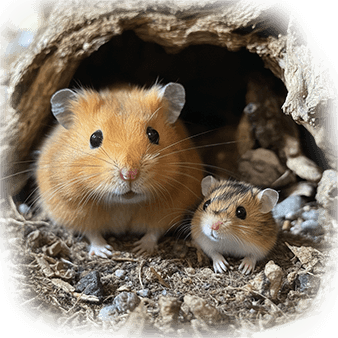Hamsters: The Tiny, Furry, Nocturnal Buddies

Hamsters are one of the most popular small pets, thanks to their manageable size, low-maintenance nature, and endearing personalities. These furry little creatures have fascinated pet lovers for years, and if you’re thinking of getting one or are just curious about their lifestyle—here’s a thorough look into the world of hamsters.
Sleeping Habits
Hamsters are nocturnal animals—which means they sleep during the day and are active at night. It might seem odd to have a pet that’s snoozing while you’re awake, but this is perfectly natural for them. Hamsters spend the majority of daylight hours sleeping, often curled up in cozy nests they create in their bedding. So, if you see your hamster catching some z’s while you’re around, don’t disturb them—it’s their prime resting time! They usually wake up in the evening, and that’s when the fun begins.

Feeding and Diet
Hamsters thrive on a balanced diet of commercial hamster food—pellets, seeds, and grains—as well as fresh fruits and vegetables. In the wild, they’re natural foragers, gathering food and hoarding it for later, and pet hamsters exhibit this behavior too. You might notice them stuffing food into their cheeks—hamsters have expandable cheek pouches, which can hold large amounts of food that they’ll transport back to their nest. Some hamster favorites include carrots, broccoli, apples, and the occasional hard-boiled egg for protein.
Interesting fact—hamsters are also prone to overeating, so be mindful of the portion sizes you give them. A balanced diet is key to keeping them healthy and avoiding obesity.

Activity and Play
Despite their small size, hamsters are super active creatures. They need plenty of exercise to stay healthy and happy. That’s where the iconic hamster wheel comes in—these little guys can run several miles in one night, and they absolutely love it! But don’t stop there—hamster tunnels, climbing toys, and wooden chews keep them entertained and provide mental stimulation. Bored hamsters can become stressed, and when they’re not busy running or exploring, they love to dig and burrow in their bedding.

Hamsters and Humans
Hamsters can make great pets for people who enjoy watching their quirky behavior. However, they’re not as social as other animals like dogs or cats. It takes time and patience to build trust with your hamster—they can be a little shy or nervous at first. Regular gentle handling and allowing them to explore your hand can help them feel more comfortable around you.
An interesting tidbit—each hamster species has its own unique personality. Syrian hamsters, for example, are typically solitary and prefer to live alone, while dwarf hamsters can sometimes live in pairs or small groups (though they can also be territorial). Always research your particular hamster breed to understand their social preferences.

Common Types of Hamsters
- Syrian Hamsters (Golden Hamsters) are the most common type kept as pets. They’re larger than other hamster species, growing up to 6–7 inches long. These hamsters are known for their golden fur and solitary nature—they must be housed alone, as they tend to fight with other hamsters.
- Dwarf Hamsters are smaller and more social compared to Syrians. They come in several varieties, like the Roborovski or Campbell’s dwarf hamster. They can live in pairs or small groups, but always introduce them carefully—dwarf hamsters can still be territorial if space is limited.
- Chinese Hamsters have longer tails than most hamsters and are often mistaken for mice because of their appearance. They are generally shy but can bond well with their owners once trust is established.

Interesting Facts About Hamsters
- Hamsters’ teeth never stop growing—so they need things to chew on constantly. Wooden chews, cardboard tubes, and gnawing toys are perfect for keeping their teeth trimmed.
- They can run up to 6 miles a night on their wheel—that’s more than most of us manage on a treadmill!
- Hamsters have a strong sense of smell and use scent glands on their bodies to mark territory. You may notice your hamster rubbing its body against surfaces in the cage—that’s their way of claiming the space as their own.
- They can store food in their cheek pouches—holding almost half their body weight! Once they’ve filled up, they’ll transport their stash back to their nest for later.

Final Thoughts
Hamsters are fascinating, energetic little creatures that make for wonderful pets. Their nocturnal habits, adorable food-hoarding behaviors, and natural curiosity are just a few things that make them so beloved. If you’re considering bringing one home, make sure you’re ready to provide plenty of enrichment and a calm, peaceful environment. And remember, these furry companions are happiest when given plenty of time to explore, run, and of course—snooze during the day!
Further reading: “The Complete Guide to Hamster Care and Ownership: Covering Breeds, Enclosures, Handling, Training, Feeding, Bonding, Grooming, Health Care, Breeding, and More!” (Amazon affiliate link) by Rianne Bruty.
Affiliate Disclosure
This post may contain affiliate links, which means I earn from purchases made through links. Please see the privacy policy page for more details.







